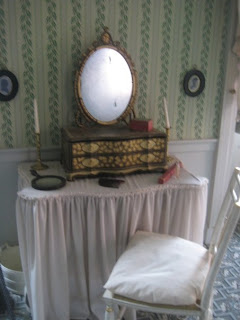Gardner-Pingree House 1804 in Salem, Massachusetts
The house showcases some of the most outstanding examples of McIntire's woodcarving, including the Corinthian capitals on the semicircular portico with semi-elliptical or semi-circular fanlight with flanking sidelights (which were original covered with 22 caret gold leaf) and the neoclassical ornaments on the mantels, doorframes, and Federal furniture of the magnificent double parlor. The Federal style was known for it's simplicity and lightness of detail. Much more refined than the heavier Georgian style.
The Gardner-Pingree House should actually be called the Gardner-West-White-Pingree House as the house was sold in 1811 to Nathaniel West when John Gardner had some financial difficulties. Three years later, West sold the house to Captain Joseph White, a wealthy, retired merchant and slave trader. White had boasted to Salem minister William Bentley in 1788 that he had “no reluctance in selling any part of the human race.” White lived in the house with a manservant and his niece, Mrs, Beckford, who worked as his housekeeper and who had a daughter that lived in Wenham, Massachusetts and was married to Joseph J. Knapp, Jr. The house was the site of the notorious 1830 murder of Capt. Joseph White, whose death prompted a famous trial prosecuted by Daniel Webster. The trial inspired Edgar Allan Poe and Nathaniel Hawthorne. To read about the murder go here A Murder in Salem .
The house is owned by the Peabody Essex Museum as part of the Essex Institute, and is open for guided tours. It features 18th and early 19th century furnishings. The house museum showcases how the upper crust lived in early 19th century America. Today we are touring the Hall, office/study, kitchen, china closet, and two bedrooms. Not that most of the rooms have costly imported wool wall to wall carpets. Although the carpets are reproductions they are made on looms that the originals were made on in England. During this period the rich were able to have wall-to-wall carpeting. Carpets were woven in widths of 27 inches, then they had to be stitched together by hand. Also not the bright colors of the carpets and busy patterns. The Federalist were not afraid of color and pattern. The furniture in theses rooms are made in Boston and Salem by Thomas Seymour and Salem's golden boy Samuel McIntire. The last bedroom is the bedroom where the notorious 1830 murder of Capt. Joseph White tuck place. Sorry my photo's are poor no flash photography allowed in the house
Gardner-Pingree House 1804 in Salem, Massachusetts
Gardner-Pingree House 1804 in Salem, Massachusetts
The central hall makes a elegant statement showing off it mint green walls. Green was the most expensive paint you could buy during this period as it was made from Verdigris dust scraped off of copper. Also note the painted floor cloth painted to look like a green and black marble tile floor.
Detail of arch in hall carved by Samuel McIntire
Detail of shaft of wheat carved by Samuel McIntire in hall. This motif of wheat was a used often by Samuel Mclntire
Shafts of wheat were popular in America during this period as we can see it on a coin silver spoon handle
Back of hall looking into the dinning room
Beautiful carving staircase
China closet
Kitchen, Who said Federalist were afraid of color
Birdcage in kitchen
Office/study
Upstairs bedroom note Beautiful half circle Federal commode made by Thomas Seymour of Boston.
The Federal bed is also made by Thomas Seymour of Boston.
The bedroom where the site of the notorious 1830 murder of Capt. Joseph White
The white and gold leafed trimmed bed was made by Samuel Mclntire note the golden Shafts of wheat
Dressing table with Chinese export dressing mirror on stand would have been the type of luxury items shipped to Salem
Gold leaf & cream colored Massachusetts made Federal period fancy chair
Beautiful cream colored Massachusetts made Federal period fancy chairs with a wish stand with hidden chamber pot
This room is very light and airy with it's Summer dress white muslin window treatment





































No comments:
Post a Comment